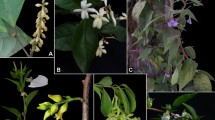Abstract
Pharmacologically safe compounds that can inhibit the proliferation of tumor cells have potential as anticancer agents. Annonaceae seems to be one of the least chemically as well as pharmacologically known families compared with its large size. Earlier studies on Annona species have showed that this family is a potent source of a wide variety of secondary metabolites belonging to several categories. The chemistry and anti-inflammatory effects of the seed oils of Annona species have been studied and published. Several antibacterial and anti-inflammatory kaurane-type diterpenes were isolated and identified, and biological evaluations were also carried out and published. The pesticidal activity of various extracts has been reported and their formulations have been tested against a wide spectrum of pests of national importance. Flowers of some Annonaceae are used in perfumery and many members of this family are used in folk medicine of some tropical countries to treat various types of cancers and tumors. In the present study we used various solvent extracts of Annona squamosa fruit pericarp to test for cytotoxic activity using in vitro cultures of Dalton’s lymphoma cells as well as HeLa cells. Cytotoxicity was detected by the Trypan blue exclusion test and induction of apoptosis was evaluated by [3-(4,5-Dimethylthiazol-2-yl)-2,5 diphenyltetrazolium bromide] assay (MTS assay) and DNA ladder assay. The chloroform extract of Annona squamosa pericarp was found to be cytotoxic to the different cell lines tested. The inhibitory concentration required for 50% cytotoxicity (IC50) was also determined. The bioactivity-directed isolation yielded two kaurane-type diterpenes, (-)-ent-kaur-16-en-19-oic acid and 16α,17-dihydroxy-ent-kauran-19-oic acid. This study suggests the potential of Annonna squamosa fruit pericarp for the development of modern medicine for the treatment of cancers.












Similar content being viewed by others
References
Cohen JJ (1991) Programmed cell death in the immune system. Adv Immunol 50:55–85
Hwang BY, Lee JH, Koo TH, Kim HS, Hong YS, Ro JS, Lee KS, Lee JJ (2001) Kaurane diterpenes from Isodon japonicus inhibit nitric oxide and prostaglandin E2 production and NF-κB activation in LPS-stimulated macrophage RAW264.7 cells. Planta Med 67:406–410
Joy B, Rao JM (1997) Chemistry of Annona squamosa leaf oil. J Essential Oil Res 9:349
Joy B Sr. Mathew M, Gopi TV (2004) Antiinflammatory effects of some Annona seed oils. Ind Drugs 41:10
Joy B, Gopi TV, Sobhana D (2006) Chemical characterization and pharmacological screening of some Annona seed oils. Asian J Chem 18:1125
Joy B and Sobhana D (2006) Antibacterial activity of kauranes from Annona squamosa fruit pericarp. Asian J Chem 19:2773–2778
Kirsh Volders M, Elhajouji A, Cundari E, Van Hummelen P (1997) The in vitro micronuclear test: A multi-endpoint assay to detect simultaneously mitotic delay, apoptosis, chromosome breakage and non-disjunction. Mutat Res 436:69–97
Fujii M, Osada H, Asakawa Y, Watanabe Y, Kondoh M, Suzuki I, Sato M, Nagashima F, Simizu S, Harad M (2004) Kaurene diterpene induces apoptosis in human leukemia cells partly through a caspase-8-dependent pathway. J Pharmacol Exp Therap Fast Forward JPET 311:115–122
Radford IR, Murphy TK, Radley JM, Ellis SL (1994) Radiation response of mouse lymphoid and myeloid cell lines Part 2. Int J Radiat Biol 65(2):217–227
Santhosh babu, J Madhusoodhana Rao, Beena Joy (1997) A process for new natural and environmentally safe biopesticide formulation for teak defoliator and some other insects. No.637/ DEL, dated 24/03/94
Scudiero DA, Shoemaker RH, Paull KD, Monks A, Tierney S, Nofziger H, Currens MJ, Seniff D, Boyd MR (1998) Evaluation of a soluble tetrazolium formasan assay for cell growth and drug sensitivity in culture using human and other tumour cell lines. Cancer Res 48:4827–4833
Radford IR, Murphy TK, Radley JM, Ellis SL (1994) Radiation response of mouse lymphoid and myeloid cell lines Part 2. Int J Radiat Biol 65(2):217–227
Acknowledgement
The authors would like to thank Prof. T. K. Chandrasekhar, Director, Regional Research laboratory, Thiruvananthapuram for continuous encouragement and financial support.
Author information
Authors and Affiliations
Corresponding author
Rights and permissions
About this article
Cite this article
Joy, B., Remani, P. Antitumor constituents from Annona squamosa fruit pericarp. Med Chem Res 17, 345–355 (2008). https://doi.org/10.1007/s00044-007-9070-3
Received:
Accepted:
Published:
Issue Date:
DOI: https://doi.org/10.1007/s00044-007-9070-3




